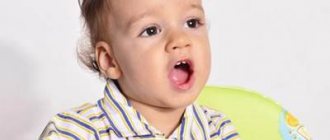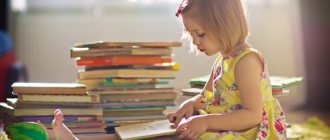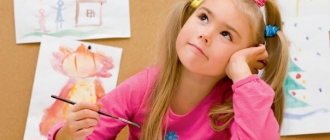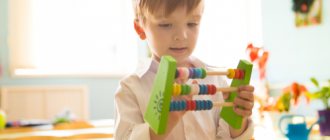Didactic games and aids for speech development of children of senior preschool age
Svetlana Toropova
Didactic games and aids for speech development of children of senior preschool age
Didactic games and aids for speech development of children of senior preschool age
The Federal State Educational Standards requirements for the results of mastering the program are presented in the form of targets for preschool education. At the stage of completing the preschool level, the child must have good command of oral speech, freely express his thoughts and desires, use speech as a means of communication, express his feelings, thoughts, and highlight sounds in words. Speech development of children is very important and relevant in preschool age.
Speech development tasks according to the Federal State Educational Standard:
Mastering speech as a means of communication and culture
enrichment of the active dictionary
development of coherent, dialogic and monologue speech
development of speech creativity
acquaintance with fiction, culture, listening comprehension of various texts, various genres of children's literature
formation of sound analytical-synthetic activity as a prerequisite for learning to read and write
development of sound and intonation culture, phonemic hearing.
To achieve and solve all problems of speech development it is necessary:
creation of a subject-development environment
selection of didactic, developmental, educational games and gaming aids
use of various methods, means, innovative technologies.
personal example of the teacher, his correctly delivered speech
consultations and various forms of work with parents on children’s speech development.
Activating children's speech using a variety of means.
In my work, to activate speech and solve all speech problems, I use the following games and gaming aids:
1. “Loto” using pure phrases for difficult sounds.
Children are offered or children themselves choose their cards, the principle of the game is like an ordinary lotto. The game is complicated by the need to repeat the correct phrase correctly, if the children know how to read, read it. Other reading children can check the correctness of the answer or determine the correctness of the pronunciation. As rewards, you can give not only cards for correct answers, but for example, counting sticks or buttons, pebbles; this is very attractive and energizing for children. If a child experiences difficulty, the teacher needs to help him, because it is difficult the first time, the game requires repetition.
For example: take the picture “Girl with balloons”
The child must repeat or read: “RY-RY-RY, I’M CARRYING BALLS” or For-for-for transparent jellyfish.”
2. “Guess the words”
The cards show two pictures, which may differ from each other when pronounced with the same sound. For example: “Cat” and “Whale”. Children select letters according to the picture, or you can complicate the task - ask a riddle. During the game, the teacher and other participants in the game can come up with riddles and a description of the object themselves. “What picture did I have in mind: this is a fluffy, mustachioed one...” The child guesses and selects the correct letter accordingly.
3. Didactic game “Gifts”
During this game, children develop sound analysis skills, the ability to determine the place of sound in a word.
Children are invited to collect gifts for the boy Roma, but all gifts must have the sound “r”. Children select pictures with a given sound, you can use diagrams, the place of the sound in the word. After the pictures have been selected, you can offer to find these toys in the group and go to visit Roma, then you can develop the role-playing game. There are many game options, fantasize yourself and with your children.
4. Games with punched cards
Punch cards are individual sheets of interesting tasks that are laminated or can be inserted into a thick file for repeated use.
The purpose of each card is different; it can be tasks such as developing phonemic perception, improving the skills of sound-letter analysis, syllabic analysis, reading syllables, composing syllables, words, sentences.
5. "Rebuses"
It’s not difficult to make these cards yourself.
2 strips are glued to the cardboard, one for inserting pictures based on the first sound of which words will be composed, the other below, for inserting letters.
You can use different options:
-which letter is missing (in the middle of the word, at the beginning or end)
- pictures or letters are placed correctly or incorrectly (self-control, mutual control)
- make a diagram
-arrange according to the diagram
6. “Syllable trainer”
Can be used in the role-playing game “School” using the following background:
-help the bear arrange consonants and vowels in the houses
-correct the bear's mistakes
-make up syllables
introduce using the Zhukova simulator to form syllables and words
-identify soft and hard sounds.
Personal trainers
7. Speech snails to reinforce the pronunciation of sounds
I have collected a card index of phonemic nursery rhymes
8. “Syllable Lotto”
The leading activity of preschool children is play; through play, the child learns about the world around him and develops comprehensively. These games contribute to the speech development of children, I hope they will be useful to you too.
How to use a lapbook when working with preschoolers
Of course, a lapbook is not just a beautiful craft for decorating a group. This is an invaluable teaching material for speech development. The following areas of its use can be distinguished:
- Lapbook for children. This is a colorful interactive folder that holds secrets. Preschoolers want to look at it and study it again and again in their free time. Unbeknownst to the children themselves, the manual encourages them to develop speech and communicate with peers and adults.
- Lapbook for teachers. This manual allows you to organize a lesson on speech development and provides ready-made material for exercises.
- Lapbook for parents. This is an opportunity to show your creative abilities, spend fun and useful time with your child, organize active communication, and an opportunity to discover the baby’s potential.
Speech development in kindergarten is carried out in a variety of activities and in different forms. A modern approach to organizing this work, in particular the use of a laptop, will make it possible to interest children, systematize their knowledge, and turn learning into an exciting process. It is quite possible to study with such benefits at home.
“Try again!” (Ozone // Labyrinth)
This book is an oasis in the world of manuals, in which, as I mentioned above, usually, if everything is good with the meaning, then everything is bad with the design.
Everything is great here. Each page has 2 lines - either a whole tongue twister, or part of it, the pictures are nice.
Tongue twisters of varying complexity, of course, three-year-old Vlad is far from capable of everything, and we don’t particularly strive for speed.
I like the clear, large print, always on a white background - the book is also suitable for children who read independently.
“Speech therapy ABC” (Ozone)
I don’t particularly like the pictures in this book (animals are tolerable, but people are a disaster!), but for some reason I often have to compromise with the manuals.
In general, it looks like this. For each letter (although it is probably more appropriate to talk about sounds here) there is a turn. On the left page in the upper corner the letter is always clearly written, in the center there are 2 poems for practicing sound. One is long, the other is short. Below is another short story/task, along the edge are pictures of objects that contain sound. Moreover, not necessarily in first place. Well, in general, as here - scarf, phone.
The most important plus is the poems with consonants, where the lines alternate: one with syllables, one just poetic. Looks like that:
Vlad simply adores all these ba-be-bi-bo-bu-by-ba, he repeats it enthusiastically, but it seems to me that he doesn’t pay attention to the lines “with meaning”, they are needed purely for a break))) In general, the poems are quite crazy , but the benefits cannot be taken away from them!
With vowels, everything is not so fun, and in general, consonants are the most popular in this book. But nevertheless, the structure of the reversal is the same.
Now the passions have already subsided, but about six months ago or a year (I don’t remember exactly when I bought it), it was just a hit!
And a bonus!!! A funny incident from life! Allow me to share, do not refuse the courtesy. When I first bought the book, I showed it to my husband, and his gaze fell on the author’s full name - b. Lagzdyn. lagzdyn?? - he asks in surprise. And I think that he wants to laugh at his last name, but which of us will undertake to judge him? But he continues without pause: Gayda? Reingoldovna? Lagzdyn?? At first it seems to me that he is joking, that he is inventing an ornate name from initials to match his surname, but I immediately understand that it is too fast and smooth! And now he’s still holding a dramatic pause, and I’m getting really scared (what do I even know about the person sitting opposite me? What other secrets does he keep??)
In general, in the end it turned out that this is our famous Tver poetess, so from time to time her name comes up in connection with some meeting with readers.
Okay, let's get back to the books))
“Noisemakers. Fairy tales with voiceover" (Ozone // Labyrinth)
This is a small book with 4 fairy tales, you read them, and the child in the right place rustles, strums, rings or makes another sound that is appropriate in meaning.
A very interesting guide, because in order to develop speech, you need to work on your hearing. Also, patience is developed in the process, because you do not need to immediately beat the drum and ring the bell indiscriminately - you need to wait for a certain moment.
We don’t play Noisemakers every day, but in general Vlad really likes them and takes them out from time to time. In general, you need to take a closer look at this series of books, there are some knockers and fairy tales with gestures. All this greatly contributes to the development of speech.
“Album on speech development for the little ones” (Ozone)
As you can see, our album was old, it even lost its cover in an unequal battle, despite the fact that V. is very careful. Really read it often. They also took it with them on trips because V. loved it, it is light and at the same time meaningful, you can work out, read fairy tales, and just look at pictures.
The period from about 9 months to 1.5 years was especially hot for the album.
There are tasks for understanding speech, where the child must show what the adult asks him to do.
There are breathing exercises and finger games, articulation exercises.
You see, yes, there are several tasks on one sheet at once, I just talked about this above.
All sorts of tasks on onomatopoeia, games.
There are fairy tales that are suggested to be told based on pictures.
At the end there are more complex thinking tasks.
In general, I really like it, and it’s inexpensive, I think it’s a must buy!
Nikolai Radlov “Stories in pictures” (Ozone // Labyrinth)
I bought this book before Vlad was born, but somehow it didn’t work for us. Although books with pictures to look at were already popular.
But then I realized that it should be used specifically for training coherent speech. Because the child must grow in his thinking to understand what is actually drawn there, especially since the pictures are humorous, and not just “mother feeding her son.”
We look at simple plots and try to recreate the story. First me, then Vlad with leading questions, some pictures - completely on his own. We haven't reached the end yet, there are 56 pages. As a rule, there is 1 story per page, but there are some that take up a full spread. All stories are about animals.
And, of course, wimmelbooks
, but we have a lot of them, I’ll write a separate post someday.
Articulation gymnastics for boys (Ozone // Labyrinth)
I already wrote about this book in a review about books with typewriters, and it is still popular among us. I repeat.
The design is also very sad, although Vlad likes it. On the plus side, the main articulation exercises are tailored to the story about the car, so it’s interesting for a boy to do all this (there is a similar one for girls, and there is also a book with breathing exercises).
If I don’t like the pictures, then the format of the book itself, in my opinion, is ideal. Usually in such publications there are several exercises on 1 sheet (or you have to use cards), this is inconvenient, the child is distracted by others, by the next spread.
And this book is on a paper clip. This means you can wrap it up so that only the exercise you are working on is visible. There is only 1 on each page.
When we first bought it, I didn’t know what to do with it. Vlad constantly pestered her and forced her to do exercises. Now it’s somehow easier because I found a secluded place for a hiding place, I take it out purely for exercise. But, by the way, he memorized the exercises, and sometimes he finds it himself, sits and does it, alone.








